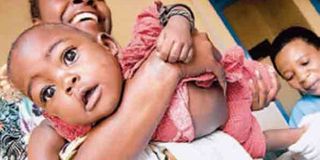Accurate test for TB in children on its way

The new test ing during the research is expected to provide the opportunity for early and accurate detection of TB in children. PHOTO | FILE
What you need to know:
- Recent reports have shown that TB in children has proved to be challenging as compared to adults. The key challenge of TB diagnosis in children is the difficulty of obtaining sputum (a mixture of saliva and mucus coughed up from the respiratory tract) for testing and also poor performance of available diagnostics tests.
The detection of childhood tuberculosis (TB) has been a challenge in Tanzania, but research experts are now in a surge to come up with a better, rapid test for many children with TB to be identified and treated.
Recent reports have shown that TB in children has proved to be challenging as compared to adults. The key challenge of TB diagnosis in children is the difficulty of obtaining sputum (a mixture of saliva and mucus coughed up from the respiratory tract) for testing and also poor performance of available diagnostics tests.
This is because children tend to have lower levels of infectious bacteria and cannot produce sputum.
Even under optimised conditions, smear microscopy, which is the standard diagnostic method in developing countries, is positive in 10 per cent to 15 per cent of children with suspected TB.
The situation in TZ
According to Kinondoni Regional Tuberculosis and Leprosy Coordinator in Dar es Salaam, Dr Mrisho Lupinda, the situation of TB in children in Tanzania in terms of data is still not encouraging. The only way to detect more children with TB in Tanzania was to seek cooperation from parents to give a detailed account about their children.
He further advised that parents and guardians should ensure that they provide a proper historical background of their children to help doctors diagnose the illness more accurately.
Tuberculosis is responsible for at least 1.5 million deaths annually despite the existence of effective treatment. Data from national TB programmes report 6 million new cases per year, but this figure is probably still 3 million short of the actual number, as many cases are not properly diagnosed or reported.
Tanzania is one of 22 high burden countries, with a TB prevalence of 295 per 100 000 population, as shown in the latest national TB prevalence survey.
A way forward
Research experts are in the preparation to start a childhood Tuberculosis (TB) research to help early detection of TB and address the important bottle necks for TB control in children in Tanzania.
The research will involve children less than fifteen years of age and will be conducted over a period of two years commencing from July 2017.
Dr Issa Sabi, Paediatrics and Child Health Specialist at the National Institute for Medical Research (NIMR), who is leading the research team in Mbeya told Your Health, “Currently childhood TB is mostly diagnosed by using clinical symptoms and testing of sputum sample which is difficult to get in children.
This research will test substances in blood which may lead to the development of the urgently needed point of care, rapid tests for childhood TB. If successful, the study benefits will extend beyond the study sites to other high TB prevalence settings with limited resources where the need is greatest,”
The research is expected to provide an opportunity for many children in Tanzania with TB to be identified and treated who otherwise would have been missed.
The research will be done in close collaboration with the Mbeya Regional Medical Office through the Regional TB and Leprosy Coordinator (RTLC) and therefore create a basis for exchange of ideas and transfer of skills beyond the research setting.




